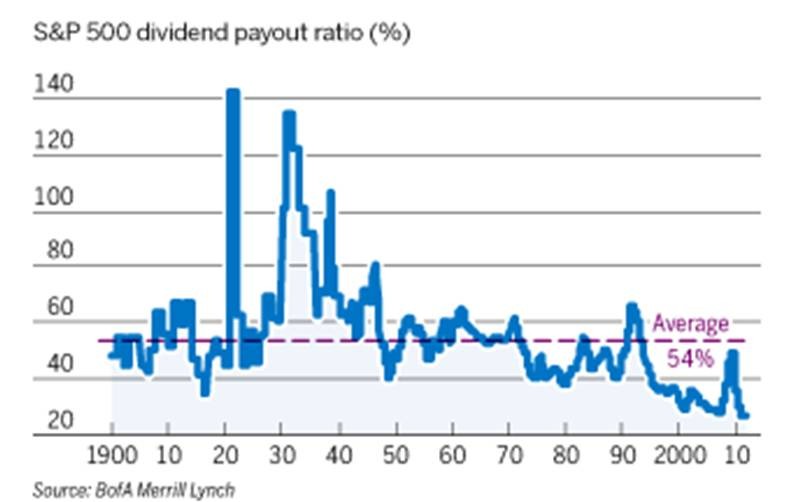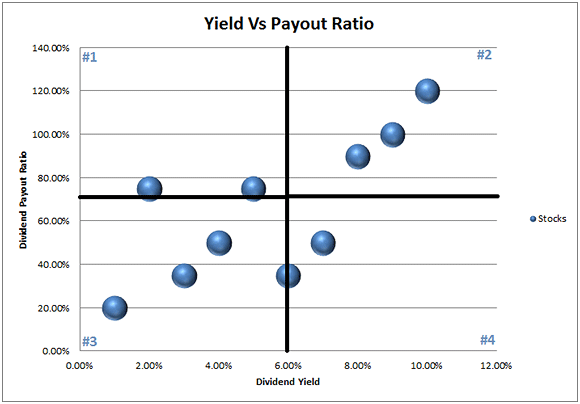The Dividend Payout Ratio
Post on: 23 Июнь, 2015 No Comment

This article was published in the July/August 2011 edition of the Canadian MoneySaver. and is posted here with permission. For more information visit www.canadianmoneysaver.ca
Many dividend investors go to great lengths to screen dividend stocks. If you stick with the big dividend aristocrats or other big blue chips, you will do just fine. Some of these companies have been paying dividends for over 50 to 100 years! The economic stability of a company like that, which also increases its dividends year after year, is money in the bank. This is what most dividend investors look for, and it is the basis of Dividend Growth Investing.
However, many good dividend paying stocks are not big blue chips with a significant dividend history, but may present good investment opportunity. They are usually higher yield stocks with smaller capitalization, but companies with a solid business plan, good management, and several years of operating revenue. The question is whether that company is a sound investment, and that is where having a set of pre-defined screening criteria comes into play.
One of the most important screening criteria I use is the Dividend Payout Ratio (DPR) . This simple ratio tells me the ability of a company to pay its dividends to shareholders, and its ability in the future in continuing to do so. The DPR also tells me whether a company has the potential to raise its dividend, or the likelihood that it may cut the dividend. In this article I examine the DPR ratio, what it means for investors, and some brief examples.
It is important to note the Dividend Payout ratio should be considered with a range of other screening criteria as well, such as dividend yield, the liabilities-to-equity ratio (a measure of debt), and the price-to-earnings ratio, etc. However on its own, the DPR can indicate how a company manages its cash flow.
How to Calculate the Dividend Payout Ratio
The DPR is very easy to calculate. The key figures you need are EPS (earnings per share) and the dollar amount of the Annual Dividend . This information is easily obtained from the Globe and Mail and many other financial web sites.
Dividend Payout Ratio = (Annual Dividend / EPS) * 100
The Dividend Payout Ratio indicates how much of a companys revenue goes into paying out its dividend to shareholders. For example a company with a Dividend Payout Ratio of 60%, would pay out 60% of its earnings as dividends to shareholders, while retaining the other 40%. As a general rule the higher the dividend yield, the higher the DPR. Conversely, big dividend blue chips and dividend aristocrats have lower DPR with a lower yield.
At the time of writing, Rogers Communications (RCI.B-T) has an annual dividend of 1.42 / EPS of 2.64, therefore the DPR = 53.7%. As another example, Wal-Mart (WMT-N) has an annual dividend of 1.46 / EPS of 4.19, so the DPR = 34.8%. The Royal Bank of Canada (RY-T) has a dividend payout ratio of 51.9% (2.00 / EPS 3.85). On the other hand Yellow Media (YLO-T) has a DPR of 120.3% (0.65 / EPS 0.54). YLO must leverage or provide an additional 0.20 cents for every 1.00 they distribute in dividends a 20% shortfall. A dividend payout ratio over 100% usually spells trouble at some point down the road.
Why the Dividend Payout Ratio Is Important
Dividend Investors focus on the Dividend Payout Ratio, because it indicates a company’s ability to continue paying dividends, and the likelihood that a company will be able to increase its dividend in the future (dividend growth). The DPR can help to determine (1) if a company is paying all of its earnings to shareholders, (2) leveraging to continue paying its dividends, or (3) leaving extra cash flow for future expansion and operating expense. Conversely it can also indicate a company that may cut its dividend, especially if its DPR is over 100%. That would indicate a company that pays out more in dividends than it earns.
Investors consider 30% to 60% as the ideal Dividend Payout Ratio. Dividend investors like to purchase stocks within this range as there is also room in the company for future growth, and possible dividend increases. A company with a lower DPR such as 30% to 40% will have the potential to raise its dividend year after year. This after all is the basis of Dividend Growth Investing. Take a company like Coca-Cola (KO-N), which has a DPR of 52.8% (1.88 / EPS 3.56), or the example of Wal-Mart (WMT-N) above with a DPR of 34.8%. Both these companies are solid blue-chips which raise their dividends.
A Good Dividend Payout Ratio = Good Management
Big companies realize the necessity of keeping cash for general revenue, as well as for future growth. They reward shareholders through a reasonable dividend yield, 3% to 5%, but also keep cash to maintain their business. For this reason alone, in my opinion, a good Dividend Payout Ratio is also a reflection of good management it shows a company that maintains fiscal responsibility.
Therefore when you see a stock with good fundamentals, but a high dividend payout ratio, you can be certain there is a long term issue behind the scenes. It could be the result of low earnings, declining sales, high debt, or even poor management. A high Dividend Payout Ratio should always be a red-flag!
Why Does a High Dividend Payout Ratio Spell Trouble?
The concern is a company with a high DPR, especially over 100%, may not be able to continue to meet its obligation to pay a dividend, since it must also pay its operating expenses and debts. It may use leverage to make the difference (i.e. issuing more shares), or may simply cut the dividend. Many small caps with higher dividend yields, especially the previous Income Trusts, have very high DPRs over 70% to 80%, and in some cases over 100% (such as Yellow Media YLO-T). Dividends don’t come out of thin air, so when a company has a DPR over 100% investors should ask themselves “Where is the money for dividend coming from? Is this a company I really want to invest in?”
The risk is once the dividend yield of a company rises over a reasonable level, and the DPR is over 100%, a company will be left with no option other than to cut its dividend. Companies avoid cutting dividends at all costs, since they lose investor confidence, and that will result in a sell-off of shares and loss in equity. However companies can’t operate effectively with a high yield either, if all their revenue is paid out in dividends. So it’s a real “Catch 22” when a company ends up in this corner. Often a company in this situation is left with no alternative but to cut the dividend.
Case in point, TransAlta (TA-T) was a company I was reviewing with its dividend yield of 5.5%, when it was recently just below $20 per share. I think TransAlta is a solid utility with good management. However, its current DPR is 117% (1.16 / EPS 0.99). That means TransAlta must provide an additional 0.17 cents for every dollar it pays out in dividends. If TransAlta wants to expand or requires further investment, then it will either have to borrow more or cut the dividend at some point. There’s been speculation around for years regarding a cut in the TransAlta dividend, and a reader on my blog already indicated TransAlta previously cut their dividend many years ago.

If you think companies don’t cut dividends then think twice! Back in early December after converting to a corporation from an Income Trust, Canadian Oil Sands (COS-T) cut its dividend some 60% down from 8.10% yield to 3% yield. However the cut was a good move for COS. Although its share price initially plummeted some 15% as investors dumped their shares, the company was a quick turnaround with surging oil prices and interest in the oil sands sector. COS now has a dividend yield of 4.10% (half of what it used to be) and a DPR of 55.8% (1.20 / EPS 2.15).
Yellow Media (YLO-T) is another company in trouble with a DPR over 120% (0.65 / EPS 0.54). This is not a good Dividend Payout Ratio, since Yellow Media must leverage an extra 0.20 cents for every $1.00 in dividends they distribute. Although the company has virtually no debt and a low Price to Earnings ratio, a DPR over 100% was the giveaway trouble was looming. Now the dividend yield is at 18.10% with a crashing share price.
What if the Dividend Payout Ratio Is Too Low?
Conversely some companies have a very low Dividend Payout Ratio, less than 30%. These companies will also have a low dividend yield. Companies such as these may want to keep cash for future expansion and other reasons that may not be apparent.
If you are investing in a low yield and low DPR company, then you are relying entirely on capital growth for your investment. That’s not to say that stocks that don’t pay dividends (or low dividend yield) are not good investments, or have less growth. Teck Resources (TCK.B-T) for example has a dividend yield of only 1.30%, but its share price soared from a low of $3.90 in March 2009, to over $62.22 in January 2011. In fact many small caps, and low dividend yield stocks have outperformed the large dividend payers in capital appreciation.
However it’s worth noting, that during the financial crisis of 2008 and 2009, those investors who held dividend stocks and stayed the course were still receiving their dividend payments. Although they endured great stress from the crisis, they were still receiving their dividends, and were able to recoup most of their losses from the ensuing market rally in 2009 and 2010.
The Top 20 Canadian Companies (by DPR)
Here are the Top 20 Canadian companies based on the lowest Dividend Payout Ratio . with a market capitalization above 500M, and a dividend yield from 3.0% to 7.0% . Ive also listed the P/E Ratio (Price-to earnings), and the L/E Ratio (liabilities-to-equity) as a measure of overall debt.
For the L/E ratio a value of 1 or below is considered a good measure. That means Brookfield Office Properties (BOX.UN-T), Emera (EMA), Sunlife (SLF-T), Rogers Communications (RCI.B-T), and TMX Group (X-T) currently carry high debt.
These stocks are listed on the TSX (Toronto Stock Exchange). This data was compiled on July 6th, 2011.














